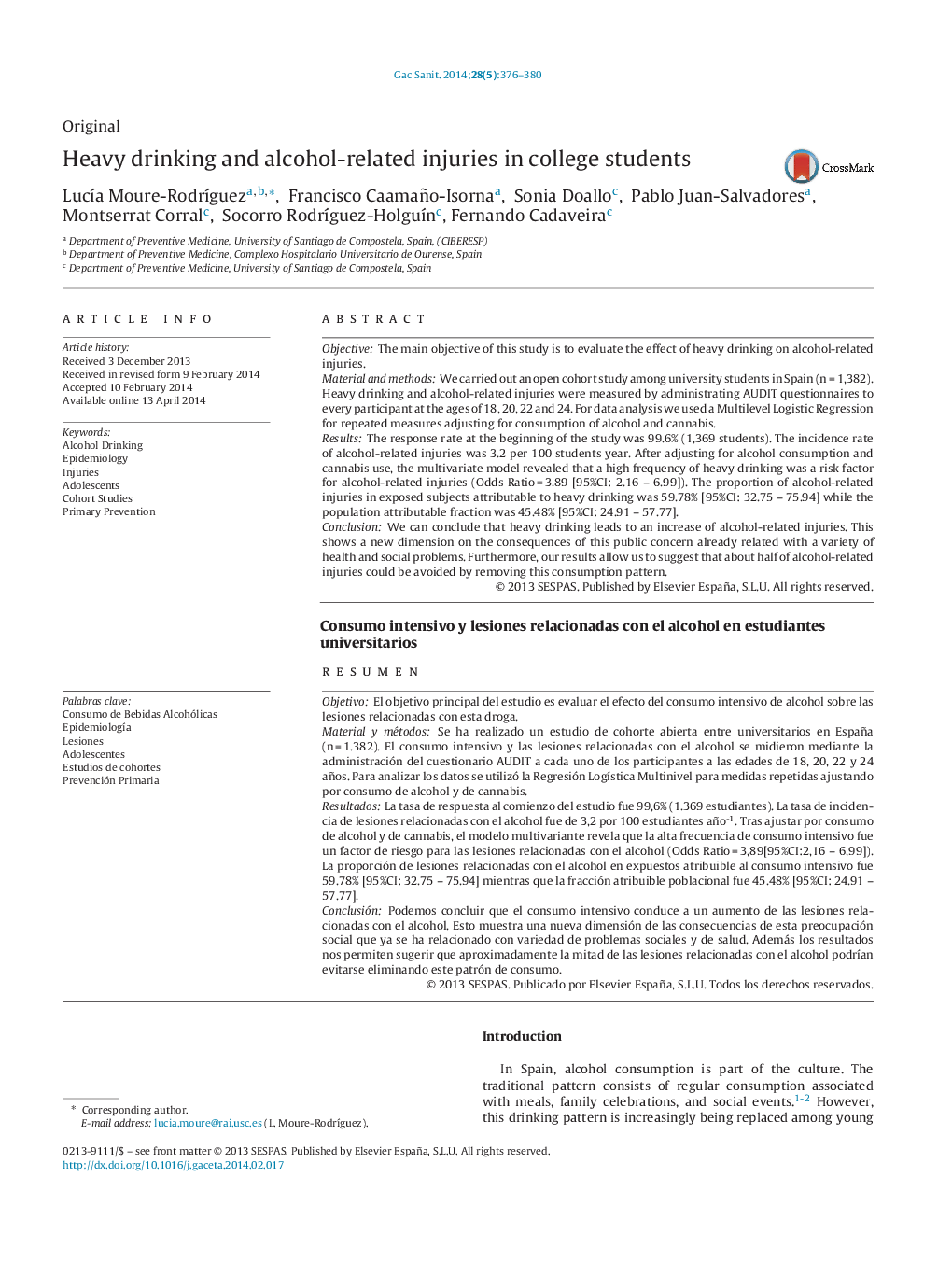| کد مقاله | کد نشریه | سال انتشار | مقاله انگلیسی | نسخه تمام متن |
|---|---|---|---|---|
| 1073499 | 949789 | 2014 | 5 صفحه PDF | دانلود رایگان |
ObjectiveThe main objective of this study is to evaluate the effect of heavy drinking on alcohol-related injuries.Material and methodsWe carried out an open cohort study among university students in Spain (n = 1,382). Heavy drinking and alcohol-related injuries were measured by administrating AUDIT questionnaires to every participant at the ages of 18, 20, 22 and 24. For data analysis we used a Multilevel Logistic Regression for repeated measures adjusting for consumption of alcohol and cannabis.ResultsThe response rate at the beginning of the study was 99.6% (1,369 students). The incidence rate of alcohol-related injuries was 3.2 per 100 students year. After adjusting for alcohol consumption and cannabis use, the multivariate model revealed that a high frequency of heavy drinking was a risk factor for alcohol-related injuries (Odds Ratio = 3.89 [95%CI: 2.16 – 6.99]). The proportion of alcohol-related injuries in exposed subjects attributable to heavy drinking was 59.78% [95%CI: 32.75 – 75.94] while the population attributable fraction was 45.48% [95%CI: 24.91 – 57.77].ConclusionWe can conclude that heavy drinking leads to an increase of alcohol-related injuries. This shows a new dimension on the consequences of this public concern already related with a variety of health and social problems. Furthermore, our results allow us to suggest that about half of alcohol-related injuries could be avoided by removing this consumption pattern.
ResumenObjetivoEl objetivo principal del estudio es evaluar el efecto del consumo intensivo de alcohol sobre las lesiones relacionadas con esta droga.Material y métodosSe ha realizado un estudio de cohorte abierta entre universitarios en España (n = 1.382). El consumo intensivo y las lesiones relacionadas con el alcohol se midieron mediante la administración del cuestionario AUDIT a cada uno de los participantes a las edades de 18, 20, 22 y 24 años. Para analizar los datos se utilizó la Regresión Logística Multinivel para medidas repetidas ajustando por consumo de alcohol y de cannabis.ResultadosLa tasa de respuesta al comienzo del estudio fue 99,6% (1.369 estudiantes). La tasa de incidencia de lesiones relacionadas con el alcohol fue de 3,2 por 100 estudiantes año-1. Tras ajustar por consumo de alcohol y de cannabis, el modelo multivariante revela que la alta frecuencia de consumo intensivo fue un factor de riesgo para las lesiones relacionadas con el alcohol (Odds Ratio = 3,89[95%CI:2,16 – 6,99]). La proporción de lesiones relacionadas con el alcohol en expuestos atribuible al consumo intensivo fue 59.78% [95%CI: 32.75 – 75.94] mientras que la fracción atribuible poblacional fue 45.48% [95%CI: 24.91 – 57.77].ConclusiónPodemos concluir que el consumo intensivo conduce a un aumento de las lesiones relacionadas con el alcohol. Esto muestra una nueva dimensión de las consecuencias de esta preocupación social que ya se ha relacionado con variedad de problemas sociales y de salud. Además los resultados nos permiten sugerir que aproximadamente la mitad de las lesiones relacionadas con el alcohol podrían evitarse eliminando este patrón de consumo.
Journal: Gaceta Sanitaria - Volume 28, Issue 5, September–October 2014, Pages 376–380
